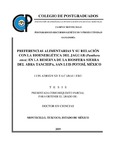Preferencias alimentarias y su relación con la bioenergética del jaguar (Panthera onca) en la Reserva de la Biosfera Sierra del Abra Tanchipa, San Luis Potosí, México.
Abstract
Las interacciones de los animales silvestres, como lo es la depredación, tienen consecuencias a diversos niveles de los ecosistemas, aquellas que involucran a los grandes carnívoros, llegan a generar profundas repercusiones en su composición y funcionamiento. La depredación contribuye notablemente al flujo y conservación de energía, asimismo interviene de manera importante en la regulación de poblaciones. Generalmente, el consumo de presas por parte los depredadores se ve regulado por la abundancia y disponibilidad de éstas, así como por las necesidades energéticas de los primeros. El jaguar (Panthera onca) es el felino más grande del continente y el único representante del género Panthera en América, no obstante, se considera que existe muy poca información cuantitativa sobre aspectos importantes de su ecología de poblaciones, historia de vida y patrones de actividad. En particular, respecto a la ecología alimentaria existen muchas suposiciones y conjeturas en cuanto a la obtención y uso de la energía por estos depredadores. El presente estudio analiza, mediante el uso de equipo de telemetría GPS los requerimientos energéticos de los jaguares que habitan la Reserva de la Biosfera Sierra del Abra Tanchipa. Durante 2016, se capturaron 3 individuos de P. onca, un adulto (JM01) y 2 subadultos (JM02, JH01) en dicha Reserva, los cuales fueron dotados de collares satelitales. Mediante el seguimiento exhaustivo de dichos individuos y el análisis de sus sitios de caza (n = 29) se registraron 37 presas muertas, siendo el Pecari tajacu, Bos taurus y Odocoileus virginianus las presas mayormente consumidas. Estas presas representaron un consumo total de 1,790.54 kg de biomasa por parte de los individuos monitoreados, los cuales, a su vez, tuvieron ámbitos hogareños de entre 62.05 y 440.0 km2. Con base en estos datos se construyó un modelo aditivo de los requerimientos energéticos del jaguar en la Reserva de la Biosfera Sierra del Abra Tanchipa. _______________ FOOD PREFERENCES AND THEIR RELATIONSHIP WITH THE BIOENERGETICS OF JAGUAR (Panthera onca) IN THE SIERRA DEL ABRA TANCHIPA BIOSPHERE RESERVE, SAN LUIS POTOSI, MEXICO. ABSTRACT: The interactions of wild animals, such as predation, have consequences at various levels of ecosystems, those that involve large carnivores, have profound repercussions on the composition and functioning of these. Predation contributes notably to the flow and conservation of energy while at the same time intervening in an important way in the regulation of populations. Generally, the consumption of prey by predators is regulated by the abundance and availability of the first ones as well as the energy needs of the predators. The jaguar (Panthera onca) is the largest feline on the continent and the only representative of the genus Panthera in America, however it is considered that there is very little quantitative information on important aspects of its population ecology, life history and activity patterns. In particular, in respect to food ecology, there are many assumptions and conjectures regarding the obtaining and use of energy by these predators. The present study analyzes, through the use of telemetry equipment, the energy requirements of the jaguars that inhabit the Sierra del Abra Tanchipa Biosphere Reserve. During 2016, 3 individuals of P. onca, one adult (JM01) and 2 subadults (JM02, JH01) were captured in that Reserve, which were equipped with satellite collars. Through the exhaustive monitoring of these individuals and the analysis of their hunting sites (n = 29), 37 dead prey have been recorded, with Pecari tajacu and Odocoileus virginianus being the most consumed prey. These prey represented a total consumption of 1,790.54 kg of biomass by the monitored individuals, who, in turn, had home ranges of between 62.05 and 440.0 km2. Based on these data, an additive model of the jaguar's energy requirements was built in the Sierra del Abra Tanchipa Biosphere Reserve.
Collections
- Tesis MC, MT, MP y DC [403]


